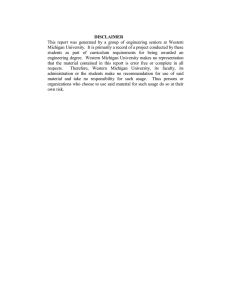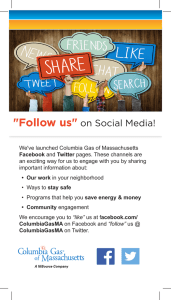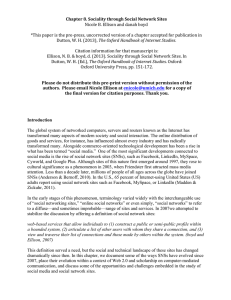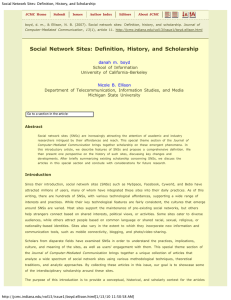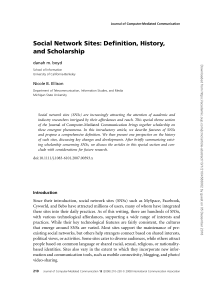Social network sites and society: Current trends and future possibilities
advertisement
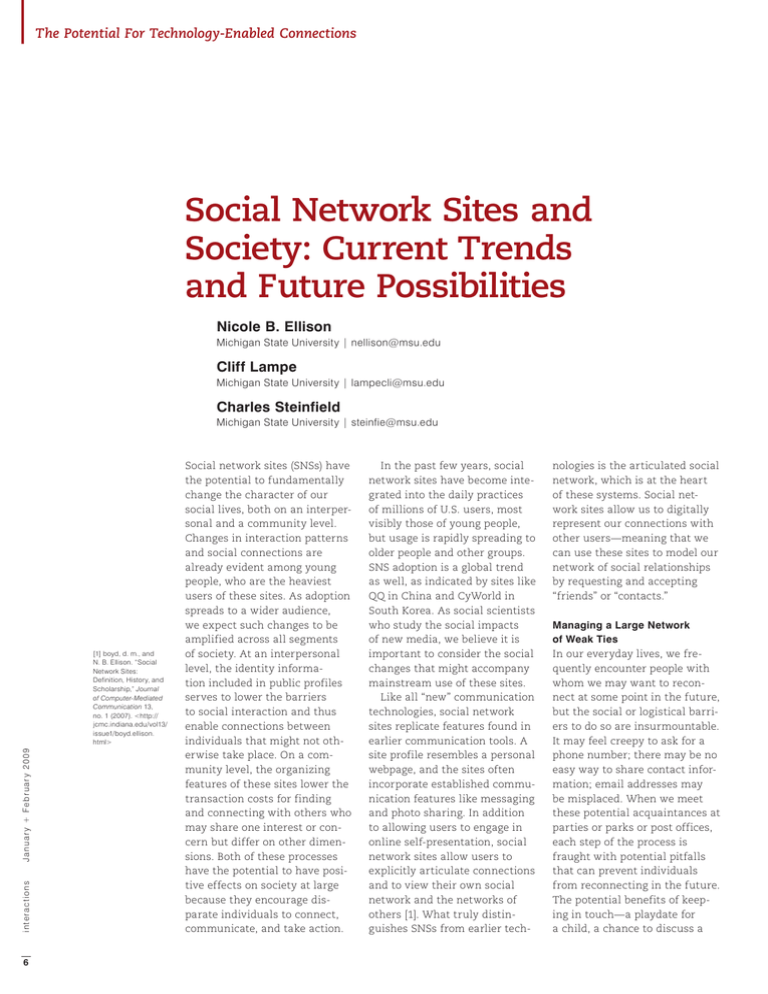
The Potential For Technology-Enabled Connections Social Network Sites and Society: Current Trends and Future Possibilities Nicole B. Ellison Michigan State University | nellison@msu.edu Cliff Lampe Michigan State University | lampecli@msu.edu Charles Steinfield Michigan State University | steinfie@msu.edu i n t e r a c t i o n s J a n u a r y + F e b r u a r y 2 0 0 9 [1] boyd, d. m., and N. B. Ellison. “Social Network Sites: Definition, History, and Scholarship,” Journal of Computer-Mediated Communication 13, no. 1 (2007). <http:// jcmc.indiana.edu/vol13/ issue1/boyd.ellison. html> 6 Social network sites (SNSs) have the potential to fundamentally change the character of our social lives, both on an interpersonal and a community level. Changes in interaction patterns and social connections are already evident among young people, who are the heaviest users of these sites. As adoption spreads to a wider audience, we expect such changes to be amplified across all segments of society. At an interpersonal level, the identity information included in public profiles serves to lower the barriers to social interaction and thus enable connections between individuals that might not otherwise take place. On a community level, the organizing features of these sites lower the transaction costs for finding and connecting with others who may share one interest or concern but differ on other dimensions. Both of these processes have the potential to have positive effects on society at large because they encourage disparate individuals to connect, communicate, and take action. In the past few years, social network sites have become integrated into the daily practices of millions of U.S. users, most visibly those of young people, but usage is rapidly spreading to older people and other groups. SNS adoption is a global trend as well, as indicated by sites like QQ in China and CyWorld in South Korea. As social scientists who study the social impacts of new media, we believe it is important to consider the social changes that might accompany mainstream use of these sites. Like all “new” communication technologies, social network sites replicate features found in earlier communication tools. A site profile resembles a personal webpage, and the sites often incorporate established communication features like messaging and photo sharing. In addition to allowing users to engage in online self-presentation, social network sites allow users to explicitly articulate connections and to view their own social network and the networks of others [1]. What truly distinguishes SNSs from earlier tech- nologies is the articulated social network, which is at the heart of these systems. Social network sites allow us to digitally represent our connections with other users—meaning that we can use these sites to model our network of social relationships by requesting and accepting “friends” or “contacts.” Managing a Large Network of Weak Ties In our everyday lives, we frequently encounter people with whom we may want to reconnect at some point in the future, but the social or logistical barriers to do so are insurmountable. It may feel creepy to ask for a phone number; there may be no easy way to share contact information; email addresses may be misplaced. When we meet these potential acquaintances at parties or parks or post offices, each step of the process is fraught with potential pitfalls that can prevent individuals from reconnecting in the future. The potential benefits of keeping in touch—a playdate for a child, a chance to discuss a FEATURE calls this the “strength of weak ties [3].” Our research into social network site use by college students suggests that these sites allow individuals to manage a wider network of weak ties and thus increase bridging social capital. As Judith Donath and danah boyd predicted in 2004, “… technologies that expand one’s social network will primarily result in an increase in available information and opportunities—the benefits of a large, heterogeneous network.” Among the undergraduates we surveyed, intensive use of Facebook was associated with higher levels of social capital, especially bridging social capital [4]. Surprisingly, broad use of the Internet didn’t increase social capital, suggesting that only certain types of online activities (such as Facebook use) influence social capital levels. Before social network sites were popular, people used communication strategies like gossip and the holiday newsletter to maintain awareness of distant friends, old coworkers, and far-flung relatives. Through status updates and feeds, SNSs enable individuals to broadcast both major life changes and ephemeral activities to their broad network, allowing others to engage in lightweight social surveillance. The coordination costs are lower because these tools enable both active (e.g., messaging) and passive (e.g., updates) communication with little effort. This awareness is especially useful for keeping tabs on those in one’s extended networks. A distant cousin got a new puppy, an old colleague has a new job, a former student is getting married: Knowing about these events won’t change one’s life, but the knowledge accumulates into a powerful awareness of one’s social network and provides continuous linkage to one’s weak ties. This ephemeral information can also strengthen offline connections, easing conversation with vague acquaintances or providing a new reason to reconnect with an old friend. Discovering Information About Others Every generation bemoans the lack of civility and increased isolation caused by the new technology of the day, and ours is no different.Today’s mobile communication devices, such as cell phones and iPods, can inhibit opportunities to engage in small pleasantries with those in our shared public spaces because these devices demand our attention and often preclude interaction with others by sending a clear message of “Do Not Disturb.” Conversely, visible accoutrements such as a young baby, a friendly dog, or a notable book can serve as identity signals that provide a safe, accessible topic of conversation for people from all walks of life. The public identity information displayed in social network site profiles can function in the same way: We can quickly identify areas of commonality with acquaintances, lowering the barriers to interaction. Students tell us that one of their first uses of Facebook is to connect with people from their hometown; even without such an obvious commonality, identity information is helpful for initiating a relationship. [2] Putnam, R. Bowling Alone: The Collapse and Revival of American Community. New York: Simon and Schuster, 2000. [3] Granovetter, M. S. “The Strength of Weak Ties.” The American Journal of Sociology 78, no.6 (1973): 1360-1380. [4] Ellison, N. B., C. Steinfield, and C. Lampe. “The Benefits of Facebook ‘Friends’: Social Capital and College Students’ Use of Online Social Network Sites.” Journal of Computer-Mediated Communication 12, no. 4 (2007). <http:// jcmc.indiana.edu/vol12/ issue4/ellison.html> i n t e r a c t i o n s J a n u a r y + F e b r u a r y 2 0 0 9 shared hobby—seem inconsequential compared to the costs of coordination, and thus the effort required to set up a future interaction seems unjustified. In other cases, the benefit of keeping in touch becomes apparent only later, after the opportunity has passed. Social network sites can help eliminate these barriers. With minimal effort and the thinnest of information, a profile can be located and a connection created. Social network sites facilitate interaction, both at that moment and in the future. The latent connection can be digitally reconstituted at any time, should the need or desire arise. For the past three years, our research team at Michigan State University has studied Facebook use among undergraduate students. The team has explored the positive outcomes of social network site use by employing a social capital theoretical lens, which gives us a grammar for describing the kinds of benefits we receive from our relationships with others. In his well-known book Bowling Alone, Robert Putnam discusses two kinds of social capital [2]. Bonding social capital comes from close friends and family in the form of emotional support and tangible resources. Bridging social capital, conversely, is associated with our “weak ties”: friends of friends, past colleagues, or other acquaintances. Our weak ties are valuable conduits to diverse perspectives and new information; research has shown that we are more likely to receive information about an employment opportunity from someone we see rarely. Sociologist Mark Granovetter 7 The Potential For Technology-Enabled Connections Social network sites provide simple, inexpensive ways to organize members, arrange meetings, spread information, and gauge opinion. As more systems emerge, there will be greater capacity for groups to organize and participate in collective action, a hallmark of i n t e r a c t i o n s J a n u a r y + F e b r u a r y 2 0 0 9 civil society. 8 [5] Sunstein, C. Republic.com. Princeton, NJ: Princeton University Press, 2001. For instance, you may not be a vegan or a Republican or a Montessori teacher, but knowing this information about a stranger can facilitate initial interaction by providing potential topics of conversation. Among acquaintances, identity information helps to develop common ground. We are often scolded about the dangers of giving up personal information, but it is also important to consider the reasons why individuals communicate identity information and the positive social outcomes that might result. In the future, social network sites might influence public and community life through the combined forces of mobility and place awareness. As mobile phones increasingly include GPS services, users can create hyper-local, ad hoc networks. The recent release of the iPhone 3G included connections to location-based SNSs, which alert users to nearby friends, blurring the line between online and offline interaction. Adding proximity information to one’s digital presence may provide additional connection opportunities that would otherwise be missed. Mobilizing Action Social network sites can assist in coordinating and mobilizing social action. Organizations, political figures, advocacy groups, regional associations, and other types of groups have various ways of using such sites: through their own profiles, site groups, or standalone networks. While a certain critical mass of users is needed for a network to have value, it’s clear there is room for a diverse ecology of sites. Focused social network sites, with populations ranging from a few hundred to a few hundred thousand, can coexist with massive global services like Myspace and Facebook. Focused site services enable people to create a tailored network, based on a variety of interests and offline associations. For instance, MyChurch unites Christian churches and Care2 addresses environmental activists. These group- and interestfocused sites encourage people to act together in new and interesting ways. Word can quickly circulate about events or planned activities, extending to each person’s network in a viral manner. In some of our own work, we’ve helped rural teens create a social network within and across their respective 4H clubs, which they use to coordinate activity (such as trading animals), share information, and build relationships. Research on social movements often focuses on the costs of coordination: the effort and expense required to reach a distributed group, provide timely information, and motivate collective action. Social network sites provide simple, inexpensive ways to organize members, arrange meetings, spread information, and gauge opinion. For example, MeetUp helped volunteers organize grassroots political activities during the 2004 U.S. presidential campaign. Similarly, Change.org, a social network site for activists, has been used to organize boycotts and protests quickly and efficiently. As more systems emerge, there will be greater capacity for groups to organize and participate in collective action, a hallmark of civil society. Beyond coordinating community organizations, social network sites can also play a role in more casual types of civil activity. A concern raised by Cass Sunstein is that Internet use will allow people to increasingly exclude viewpoints that conflict with their own, creating a bubble of information in which individuals are exposed only to data that reinforces their current opinions [5]. Social network sites allow users to state their political affiliations or become FEATURE Evolving Use and the Need for New Research Overall, we believe that the potential for positive social outcomes is great. Clearly, by any measure, social network sites are changing the way we form and maintain our relationships with others, with demonstrable benefits. As they evolve and spread, we expect network effects to occur and their social utility to increase. Many questions remain, however, for researchers, designers, and practitioners, including: • How can the power of social network sites be leveraged in other contexts, including formal organizations? Research on corporate social network sites, like IBM’s internal SNS Beehive, suggests that users welcome learning more about their colleagues’ lives, and that this information is used to facilitate social interactions that directly and indirectly support job-related tasks. • How can social network sites support individuals as they make life transitions, such as moving to a new city or starting a new job? Our research on Facebook suggests that such sites can help students maintain past connections and initiate new relationships during their transition to college, but we don’t yet understand how these findings apply to other groups or what kinds of features best support these needs. • How can the mobilizing power of social network sites increase community and political engagement, especially among traditionally disenfranchised groups? As social network sites are adopted by broader segments of society, how will usage practices, risks, and benefits change? As highlighted by survey work by Eszter Hargattai [6], choice of social network site is influenced by cultural and socio-economic factors, which may limit individuals’ opportunities to interact with those from different backgrounds. Are all SNS users getting the same benefits from their use? How can we overcome these barriers, or at least minimize their impact? For designers and creators of these systems, these questions highlight the need to better understand how they must adapt in order to support diverse populations and goals. In the simplest case, these adaptations could mean revising profile categories to better align with different cultural contexts (e.g., shielding work colleagues from identity information such as sexual orientation). We do not mean to suggest that all social network site activity is positive. Personal information about others may be used to broker productive interaction, but it could also reinforce existing stereotypes, making them more intractable. Personal information may be misused by marketing agents or used for nefarious purposes such as stalking, bullying, and identity theft. But overall we are hopeful that the technical and social affordances of these sites may contribute to positive social outcomes by enabling individuals to talk, act, and connect with diverse strangers, acquaintances, and friends. About the Authors Nicole Ellison is an assistant professor in the department of telecommunication, information studies, and media at Michigan State University. Her research explores issues of self-presentation, relationship development, and identity in online environments such as online dating services and social network sites. Currently, she is exploring the social capital implications of Facebook use, educational applications of SNSs, and the nature of “friends” online. Nicole received her Ph.D. in communication theory and research from the Annenberg School for Communication at USC. Charles Steinfield is a professor and chair in the department of telecommunication, information studies, and media at Michigan State University. His research interests include the uses of online social networks, individual and organizational collaboration via ICT, and e-commerce. He is currently pursuing projects on social capital and online SNS use, collective action and the diffusion of information technology standards, and ICT use in knowledge-oriented business clusters. Cliff Lampe is an assistant professor in the department of telecommunication, information studies, and media at Michigan State University. His Ph.D. is from the School of Information at the University of Michigan. He studies social interactions in online environments, including Facebook, Slashdot, Everything2, and SourceForge. In particular, he’s interested in the use of information technology to support collective action. DOI: 10.1145/1456202.1456204 © 2009 ACM 1072-5220/09/0100 $5.00 [6] Hargattai, E. “Whose Space? Differences Among Users and Non-Users of Social Network Sites.” Journal of Computer-Mediated Communication 13, no. 1 (2007). <http://jcmc. indiana.edu/vol13/ issue1/hargittai.html> i n t e r a c t i o n s J a n u a r y + F e b r u a r y 2 0 0 9 “fans” of political candidates or causes; thus we may learn that a colleague we respect is a fan of a political candidate we oppose. The inclusion of political views in site profiles allows users to be exposed to differing viewpoints, potentially increasing discourse and even tolerance among those with opposing ideas. 9
